Case Study: Human Resource Management Issues and Uber's Challenges
VerifiedAdded on 2020/03/23
|9
|2425
|48
Report
AI Summary
This report provides a comprehensive case study analysis of the human resource management challenges faced by Uber. It begins with an executive summary and introduction, followed by a discussion of a news story concerning Uber's unfair dismissal cases and the company's practice of classifying drivers as contractors rather than employees. The report delves into specific human resource issues within Uber, such as the inefficiency of the HR department in aligning drivers' interests with the business, low employee retention rates, lack of employee engagement, and inadequate compensation. It connects these issues to relevant HR theories, including employee engagement and corporate social responsibility, to provide a theoretical framework for understanding the problems. The report concludes with recommendations for Uber, suggesting improvements such as ending contractor relationships, treating drivers as employees, improving employee engagement, and implementing incentive schemes. The report references various academic sources to support its arguments and recommendations.
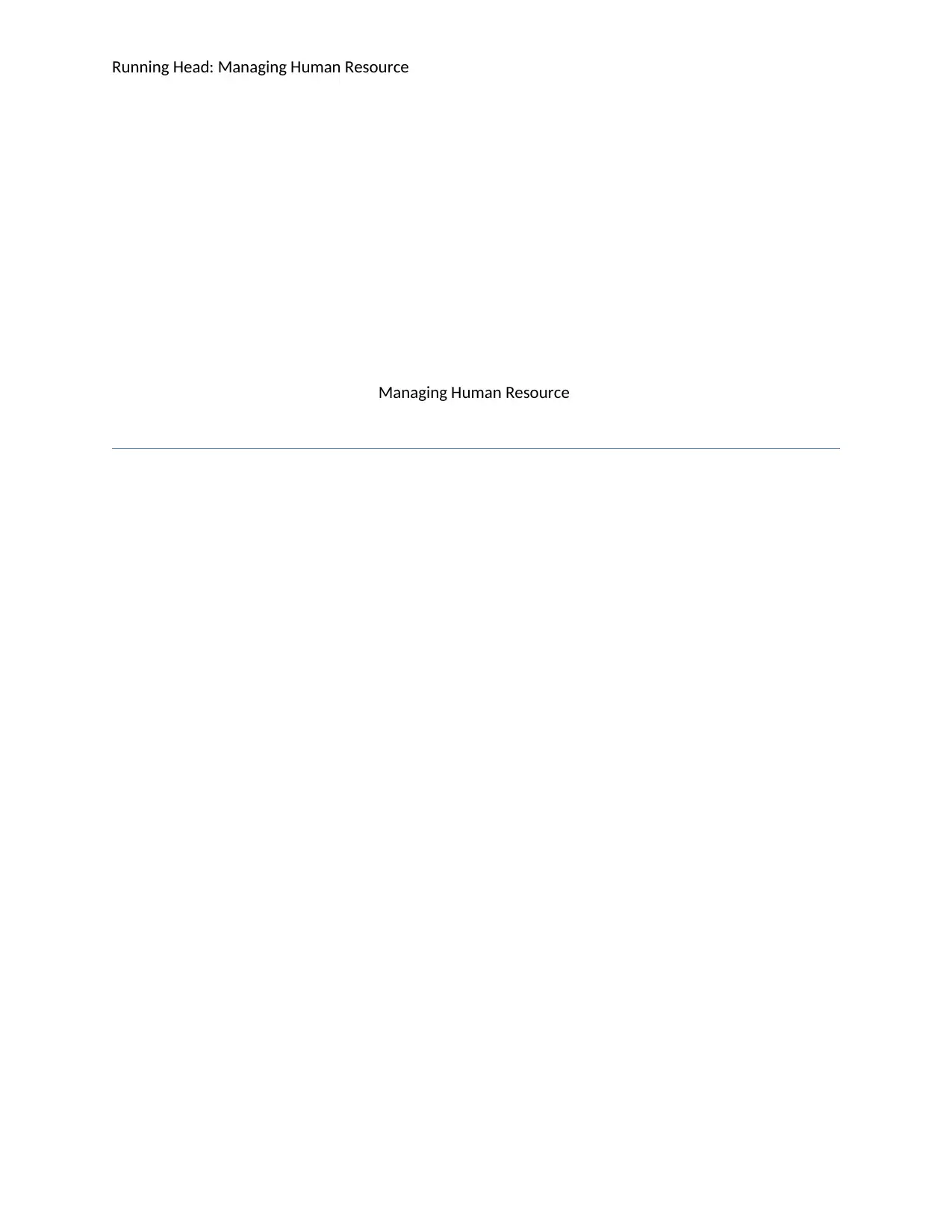
Running Head: Managing Human Resource
Managing Human Resource
Managing Human Resource
Paraphrase This Document
Need a fresh take? Get an instant paraphrase of this document with our AI Paraphraser
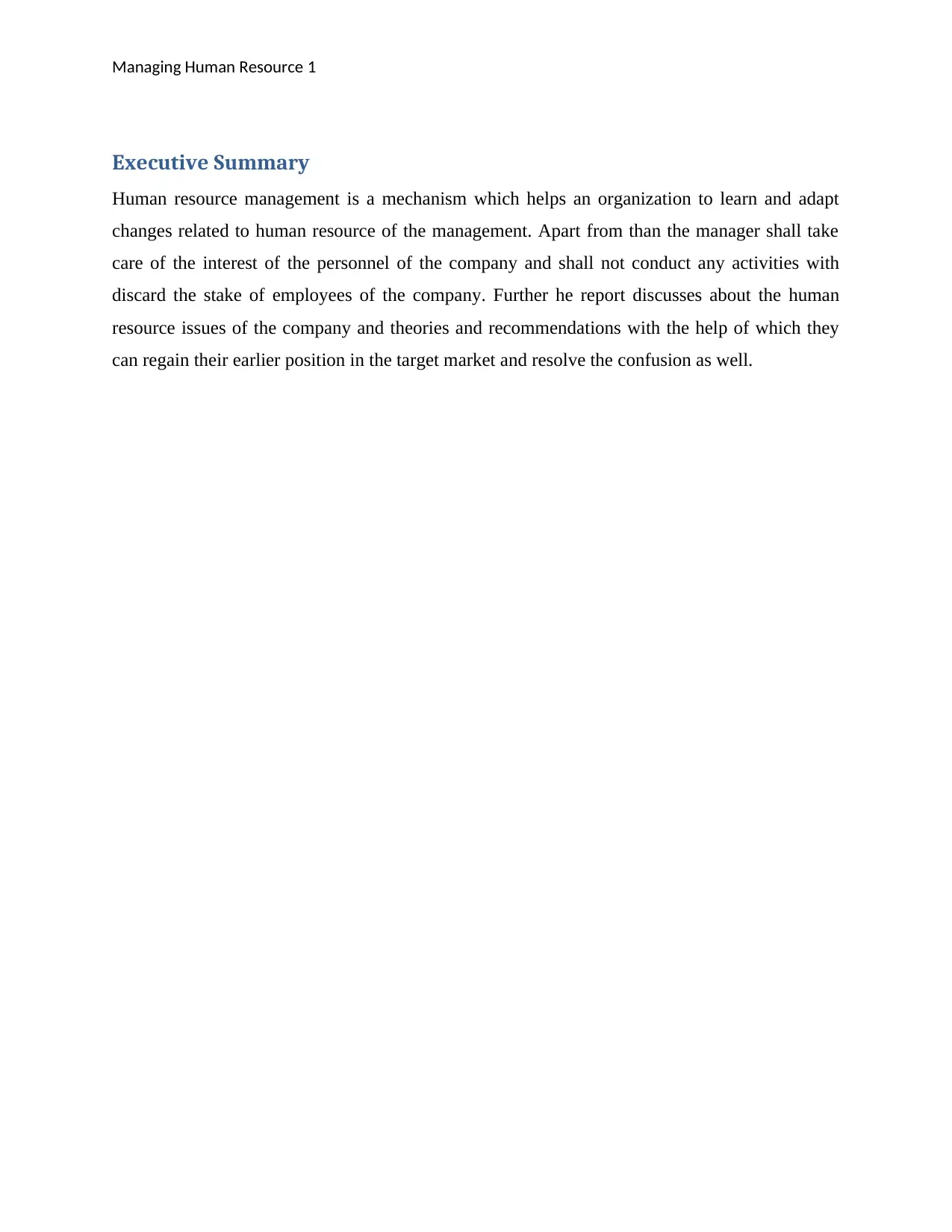
Managing Human Resource 1
Executive Summary
Human resource management is a mechanism which helps an organization to learn and adapt
changes related to human resource of the management. Apart from than the manager shall take
care of the interest of the personnel of the company and shall not conduct any activities with
discard the stake of employees of the company. Further he report discusses about the human
resource issues of the company and theories and recommendations with the help of which they
can regain their earlier position in the target market and resolve the confusion as well.
Executive Summary
Human resource management is a mechanism which helps an organization to learn and adapt
changes related to human resource of the management. Apart from than the manager shall take
care of the interest of the personnel of the company and shall not conduct any activities with
discard the stake of employees of the company. Further he report discusses about the human
resource issues of the company and theories and recommendations with the help of which they
can regain their earlier position in the target market and resolve the confusion as well.
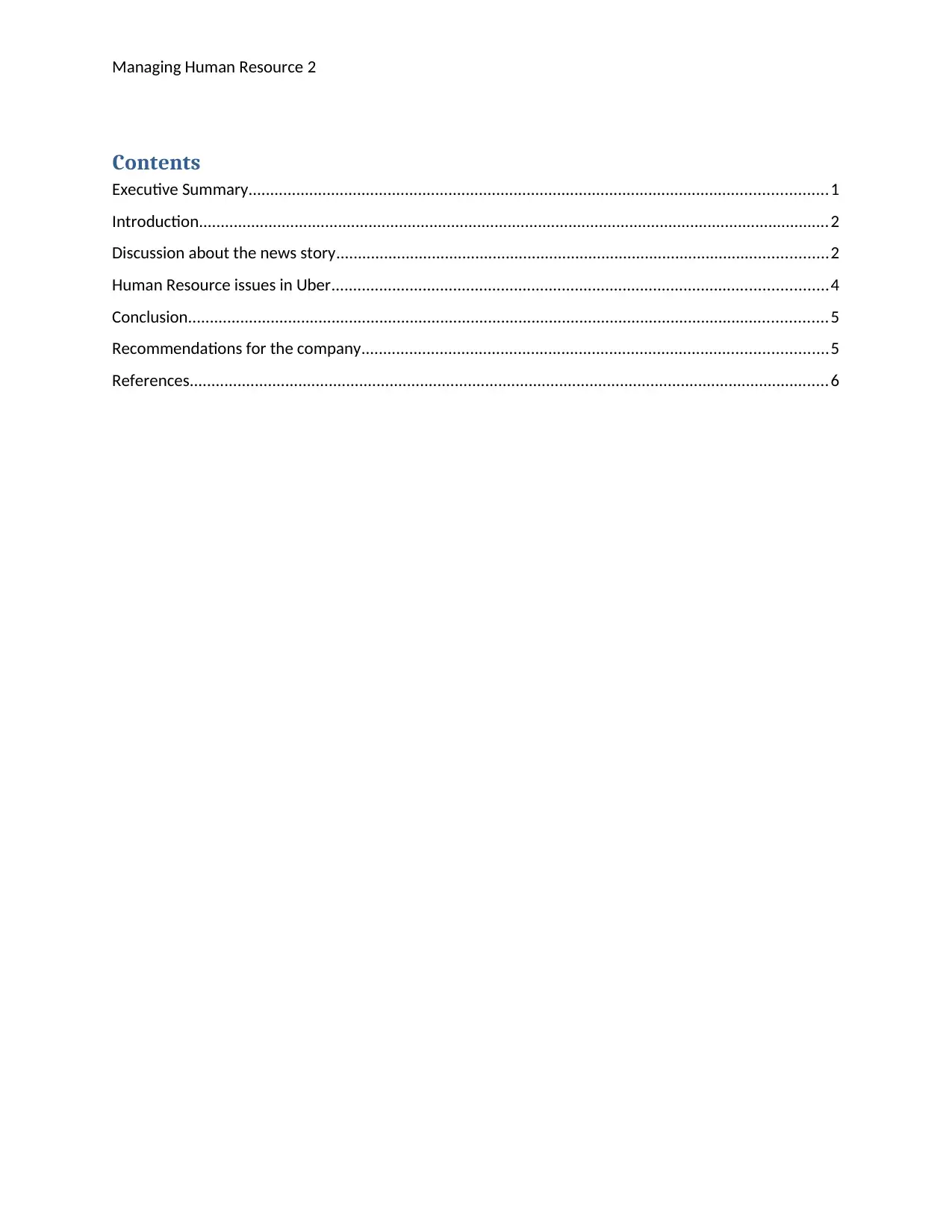
Managing Human Resource 2
Contents
Executive Summary.....................................................................................................................................1
Introduction.................................................................................................................................................2
Discussion about the news story.................................................................................................................2
Human Resource issues in Uber..................................................................................................................4
Conclusion...................................................................................................................................................5
Recommendations for the company...........................................................................................................5
References...................................................................................................................................................6
Contents
Executive Summary.....................................................................................................................................1
Introduction.................................................................................................................................................2
Discussion about the news story.................................................................................................................2
Human Resource issues in Uber..................................................................................................................4
Conclusion...................................................................................................................................................5
Recommendations for the company...........................................................................................................5
References...................................................................................................................................................6
⊘ This is a preview!⊘
Do you want full access?
Subscribe today to unlock all pages.

Trusted by 1+ million students worldwide

Managing Human Resource 3
Introduction
Human resource management is the key player which affects the growth of the company in the
global market. It is also responsible for keeping a positive image of the company in front of
visitors. It is the duty of the HR manager to maximize the performance of employees and keep
them interested in the activities of the business. Without adequate human resource measure, an
organization cannot successfully carry on their business transaction, ultimately due to which they
will face dissatisfaction among employees in the management (Armstrong, & Taylor, 2014).
Talking about the company Uber, it is an identified innovative company present in the global
market. Uber calls it customer Uber partners which initiates the job seekers join the company due
to fancy titles. Nut it is the inefficiency of the human resource department that they are unable to
stand up to the expectations of the employees of the company. Further, the business report
discusses are about the new article about Uber employee issues and human resource theories
which the company shall adopt in order to understand the case. Further, it also includes
recommendations to the company with the aid of which they can again attain the former position
in the target. Further details of the task are discussed below.
Discussion about the news story
The news story discusses the case in which Uber is settling unfair dismissal cases. The core of
the news article is that the company is breaching the rights of the employees (drivers) of the
company by regarding them as only drivers, not the actual employees of the further. Further to
elaborate the case it shall be said that the AFR reported that the company is not accepting that the
drivers who are working for them are the employees of the company (Thijssens, Bollen, &
Hassink, 2015). It further states that the Rideshare Drivers Association of Australia filed a claim
against the company that Uber is practicing unethical activities which are harnessing the interest
of the drivers who are associated with the activities of the company. The case was submitted to
the fair work commission for the avoidance of contractor relationship with the company. In this
case, it shall be noticed that the company smartly played a trick by calling their divers partners
not the employee of the company (Collings, 2014). With this effect, they secured themselves
from the liability of calling drivers employees, and they initiated a contractual relationship with
Introduction
Human resource management is the key player which affects the growth of the company in the
global market. It is also responsible for keeping a positive image of the company in front of
visitors. It is the duty of the HR manager to maximize the performance of employees and keep
them interested in the activities of the business. Without adequate human resource measure, an
organization cannot successfully carry on their business transaction, ultimately due to which they
will face dissatisfaction among employees in the management (Armstrong, & Taylor, 2014).
Talking about the company Uber, it is an identified innovative company present in the global
market. Uber calls it customer Uber partners which initiates the job seekers join the company due
to fancy titles. Nut it is the inefficiency of the human resource department that they are unable to
stand up to the expectations of the employees of the company. Further, the business report
discusses are about the new article about Uber employee issues and human resource theories
which the company shall adopt in order to understand the case. Further, it also includes
recommendations to the company with the aid of which they can again attain the former position
in the target. Further details of the task are discussed below.
Discussion about the news story
The news story discusses the case in which Uber is settling unfair dismissal cases. The core of
the news article is that the company is breaching the rights of the employees (drivers) of the
company by regarding them as only drivers, not the actual employees of the further. Further to
elaborate the case it shall be said that the AFR reported that the company is not accepting that the
drivers who are working for them are the employees of the company (Thijssens, Bollen, &
Hassink, 2015). It further states that the Rideshare Drivers Association of Australia filed a claim
against the company that Uber is practicing unethical activities which are harnessing the interest
of the drivers who are associated with the activities of the company. The case was submitted to
the fair work commission for the avoidance of contractor relationship with the company. In this
case, it shall be noticed that the company smartly played a trick by calling their divers partners
not the employee of the company (Collings, 2014). With this effect, they secured themselves
from the liability of calling drivers employees, and they initiated a contractual relationship with
Paraphrase This Document
Need a fresh take? Get an instant paraphrase of this document with our AI Paraphraser
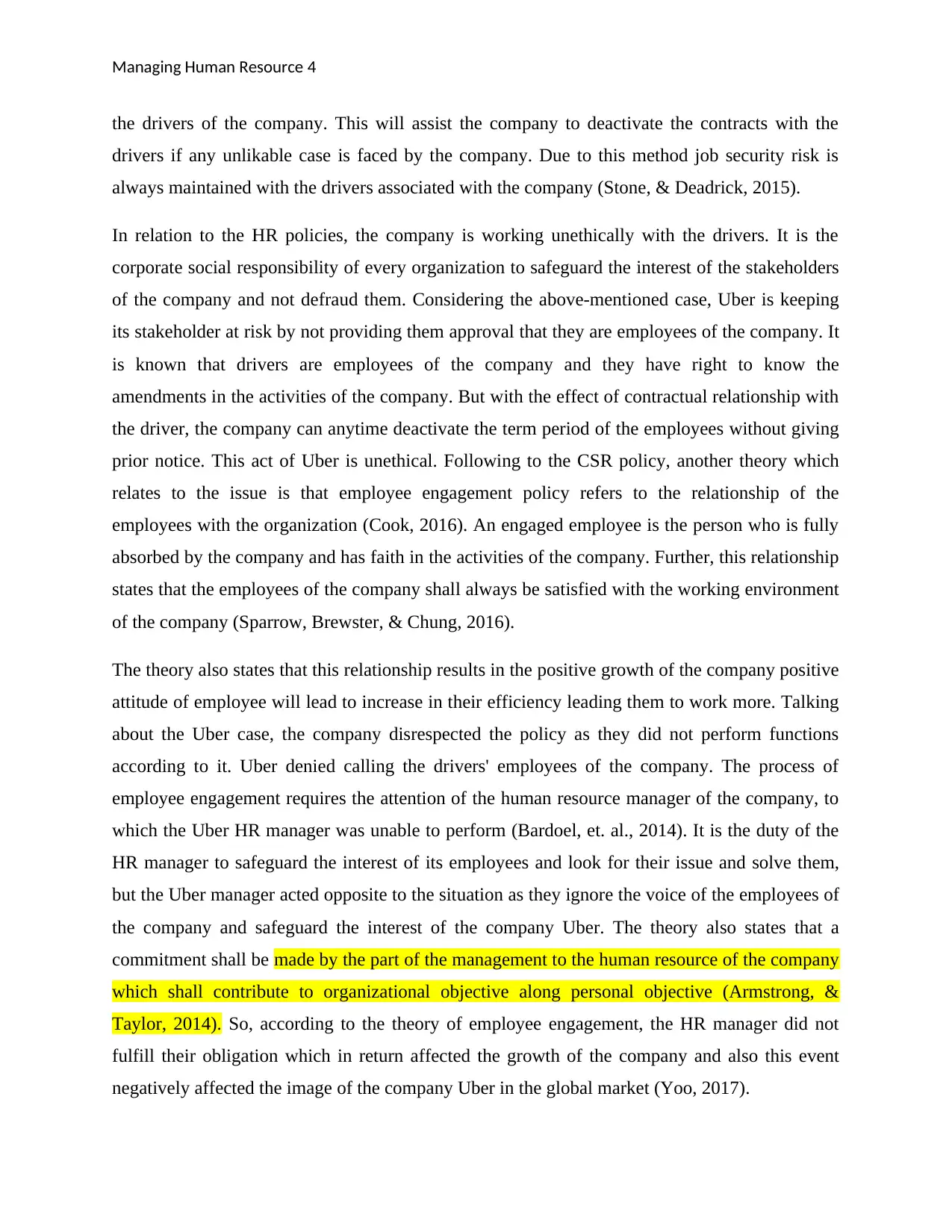
Managing Human Resource 4
the drivers of the company. This will assist the company to deactivate the contracts with the
drivers if any unlikable case is faced by the company. Due to this method job security risk is
always maintained with the drivers associated with the company (Stone, & Deadrick, 2015).
In relation to the HR policies, the company is working unethically with the drivers. It is the
corporate social responsibility of every organization to safeguard the interest of the stakeholders
of the company and not defraud them. Considering the above-mentioned case, Uber is keeping
its stakeholder at risk by not providing them approval that they are employees of the company. It
is known that drivers are employees of the company and they have right to know the
amendments in the activities of the company. But with the effect of contractual relationship with
the driver, the company can anytime deactivate the term period of the employees without giving
prior notice. This act of Uber is unethical. Following to the CSR policy, another theory which
relates to the issue is that employee engagement policy refers to the relationship of the
employees with the organization (Cook, 2016). An engaged employee is the person who is fully
absorbed by the company and has faith in the activities of the company. Further, this relationship
states that the employees of the company shall always be satisfied with the working environment
of the company (Sparrow, Brewster, & Chung, 2016).
The theory also states that this relationship results in the positive growth of the company positive
attitude of employee will lead to increase in their efficiency leading them to work more. Talking
about the Uber case, the company disrespected the policy as they did not perform functions
according to it. Uber denied calling the drivers' employees of the company. The process of
employee engagement requires the attention of the human resource manager of the company, to
which the Uber HR manager was unable to perform (Bardoel, et. al., 2014). It is the duty of the
HR manager to safeguard the interest of its employees and look for their issue and solve them,
but the Uber manager acted opposite to the situation as they ignore the voice of the employees of
the company and safeguard the interest of the company Uber. The theory also states that a
commitment shall be made by the part of the management to the human resource of the company
which shall contribute to organizational objective along personal objective (Armstrong, &
Taylor, 2014). So, according to the theory of employee engagement, the HR manager did not
fulfill their obligation which in return affected the growth of the company and also this event
negatively affected the image of the company Uber in the global market (Yoo, 2017).
the drivers of the company. This will assist the company to deactivate the contracts with the
drivers if any unlikable case is faced by the company. Due to this method job security risk is
always maintained with the drivers associated with the company (Stone, & Deadrick, 2015).
In relation to the HR policies, the company is working unethically with the drivers. It is the
corporate social responsibility of every organization to safeguard the interest of the stakeholders
of the company and not defraud them. Considering the above-mentioned case, Uber is keeping
its stakeholder at risk by not providing them approval that they are employees of the company. It
is known that drivers are employees of the company and they have right to know the
amendments in the activities of the company. But with the effect of contractual relationship with
the driver, the company can anytime deactivate the term period of the employees without giving
prior notice. This act of Uber is unethical. Following to the CSR policy, another theory which
relates to the issue is that employee engagement policy refers to the relationship of the
employees with the organization (Cook, 2016). An engaged employee is the person who is fully
absorbed by the company and has faith in the activities of the company. Further, this relationship
states that the employees of the company shall always be satisfied with the working environment
of the company (Sparrow, Brewster, & Chung, 2016).
The theory also states that this relationship results in the positive growth of the company positive
attitude of employee will lead to increase in their efficiency leading them to work more. Talking
about the Uber case, the company disrespected the policy as they did not perform functions
according to it. Uber denied calling the drivers' employees of the company. The process of
employee engagement requires the attention of the human resource manager of the company, to
which the Uber HR manager was unable to perform (Bardoel, et. al., 2014). It is the duty of the
HR manager to safeguard the interest of its employees and look for their issue and solve them,
but the Uber manager acted opposite to the situation as they ignore the voice of the employees of
the company and safeguard the interest of the company Uber. The theory also states that a
commitment shall be made by the part of the management to the human resource of the company
which shall contribute to organizational objective along personal objective (Armstrong, &
Taylor, 2014). So, according to the theory of employee engagement, the HR manager did not
fulfill their obligation which in return affected the growth of the company and also this event
negatively affected the image of the company Uber in the global market (Yoo, 2017).

Managing Human Resource 5
Human Resource issues in Uber
In context to the news article on the issues faced by the Uber company, the fact that shall be
taken into account is that the acts which company performed in their management were wrong
due to which the company had to face the following issues in their business process. Further, the
problems of Uber Company are discussed below:
The initial and foremost important HR issue faced by the company is the inefficiency of
HR manager to keep the interest of drivers aligned with the core activity of the business.
Irrespective of the share of the drivers in deciding business rules, the company initiated
contractor relationship with them. This act of the company disregarded the right of
drivers (Hoque, 2013).
Another human resource issues faced by the company is that there is a low degree of
employee retention in the company. The employees keep on switching their jobs from the
company Uber. The working environment and the culture of Uber are not fit for the
people to stay for a longer period of time as the company is unable to motivate their
employees to stay for a longer period of time (Stone, 2013). Even the company focused
on new recruitments and forgets the interest of people already hired. The company lacks
the employee engagement process due to which they are facing such issues in their
management (Søderberg, Krishna, & Bjørn, 2013).
The company Uber does not call their drivers as a part of the company, which means they
initiate a relationship with the employees on the basis of the contract and do not treat
them as employees of the company. Due to this process, the drivers are unable to hold
their rights in the working of the company. Implementation of such activity in the
business process is the corporate social responsibility of the company. In order to attain a
sustainable growth, most importantly the manager needs to keep the assets (employees)
of the company intact then only they can earn competitive advantage in the global market
(Breevaart, et., 2014).
Lastly, the company does not pay to employees adequately due to which dissatisfaction
occurs in their attitude. According to Herzberg’s theory of motivation, in order to attain
safety, the employees need job security along with optimum pay to keep them motivated
towards the target (Stone, n.d.).
Human Resource issues in Uber
In context to the news article on the issues faced by the Uber company, the fact that shall be
taken into account is that the acts which company performed in their management were wrong
due to which the company had to face the following issues in their business process. Further, the
problems of Uber Company are discussed below:
The initial and foremost important HR issue faced by the company is the inefficiency of
HR manager to keep the interest of drivers aligned with the core activity of the business.
Irrespective of the share of the drivers in deciding business rules, the company initiated
contractor relationship with them. This act of the company disregarded the right of
drivers (Hoque, 2013).
Another human resource issues faced by the company is that there is a low degree of
employee retention in the company. The employees keep on switching their jobs from the
company Uber. The working environment and the culture of Uber are not fit for the
people to stay for a longer period of time as the company is unable to motivate their
employees to stay for a longer period of time (Stone, 2013). Even the company focused
on new recruitments and forgets the interest of people already hired. The company lacks
the employee engagement process due to which they are facing such issues in their
management (Søderberg, Krishna, & Bjørn, 2013).
The company Uber does not call their drivers as a part of the company, which means they
initiate a relationship with the employees on the basis of the contract and do not treat
them as employees of the company. Due to this process, the drivers are unable to hold
their rights in the working of the company. Implementation of such activity in the
business process is the corporate social responsibility of the company. In order to attain a
sustainable growth, most importantly the manager needs to keep the assets (employees)
of the company intact then only they can earn competitive advantage in the global market
(Breevaart, et., 2014).
Lastly, the company does not pay to employees adequately due to which dissatisfaction
occurs in their attitude. According to Herzberg’s theory of motivation, in order to attain
safety, the employees need job security along with optimum pay to keep them motivated
towards the target (Stone, n.d.).
⊘ This is a preview!⊘
Do you want full access?
Subscribe today to unlock all pages.

Trusted by 1+ million students worldwide

Managing Human Resource 6
Conclusion
Thus, in the limelight of above mentioned events, the act that shall be stated is that the company
Uber has several issues in its human resource management system, apart from which the
company is acting ethical wrong with the drivers of the organization. Thus, the report provides
issue and recommendation to the company regarding the managerial issues.
Recommendations for the company
The following are the few recommendation with the use of which the company can
initiate adequate human resource techniques in their management system.
The HR manager shall personally look after the case, and analyze the defaulter, even if
the company is at fault, they shall amend the measure to safeguard the interest of drivers
of the company (Alfes, et. al., 2013).
The contractor relationship shall be put to an end so that no rights of the drivers are
breached. Apart from that, the drivers shall also be called as the employee of the
company as they serve to the core activity of the business.
The top management of the company shall circulate their response to the public in favor
of the interest of the employees so that their image is maintained.
Keeping in mind the employee engagement theory the management shall activities which
adequately maintain a good employer-employee relationship in the internal process of the
company (Saks, & Gruman, 2014).
The company shall create laws fulfill their corporate social responsibility against the
society. Also keeping in mind the stakeholder theory, the company shall work to provide
maximum benefits to the stakeholder so the company, not only personal goals shall be
satisfied but all stakeholders shall gain benefit with the growth of the company.
Incentive scheme shall be initiated in the management of the company for efficient
employees (Cho, et. al., 2015).
Conclusion
Thus, in the limelight of above mentioned events, the act that shall be stated is that the company
Uber has several issues in its human resource management system, apart from which the
company is acting ethical wrong with the drivers of the organization. Thus, the report provides
issue and recommendation to the company regarding the managerial issues.
Recommendations for the company
The following are the few recommendation with the use of which the company can
initiate adequate human resource techniques in their management system.
The HR manager shall personally look after the case, and analyze the defaulter, even if
the company is at fault, they shall amend the measure to safeguard the interest of drivers
of the company (Alfes, et. al., 2013).
The contractor relationship shall be put to an end so that no rights of the drivers are
breached. Apart from that, the drivers shall also be called as the employee of the
company as they serve to the core activity of the business.
The top management of the company shall circulate their response to the public in favor
of the interest of the employees so that their image is maintained.
Keeping in mind the employee engagement theory the management shall activities which
adequately maintain a good employer-employee relationship in the internal process of the
company (Saks, & Gruman, 2014).
The company shall create laws fulfill their corporate social responsibility against the
society. Also keeping in mind the stakeholder theory, the company shall work to provide
maximum benefits to the stakeholder so the company, not only personal goals shall be
satisfied but all stakeholders shall gain benefit with the growth of the company.
Incentive scheme shall be initiated in the management of the company for efficient
employees (Cho, et. al., 2015).
Paraphrase This Document
Need a fresh take? Get an instant paraphrase of this document with our AI Paraphraser
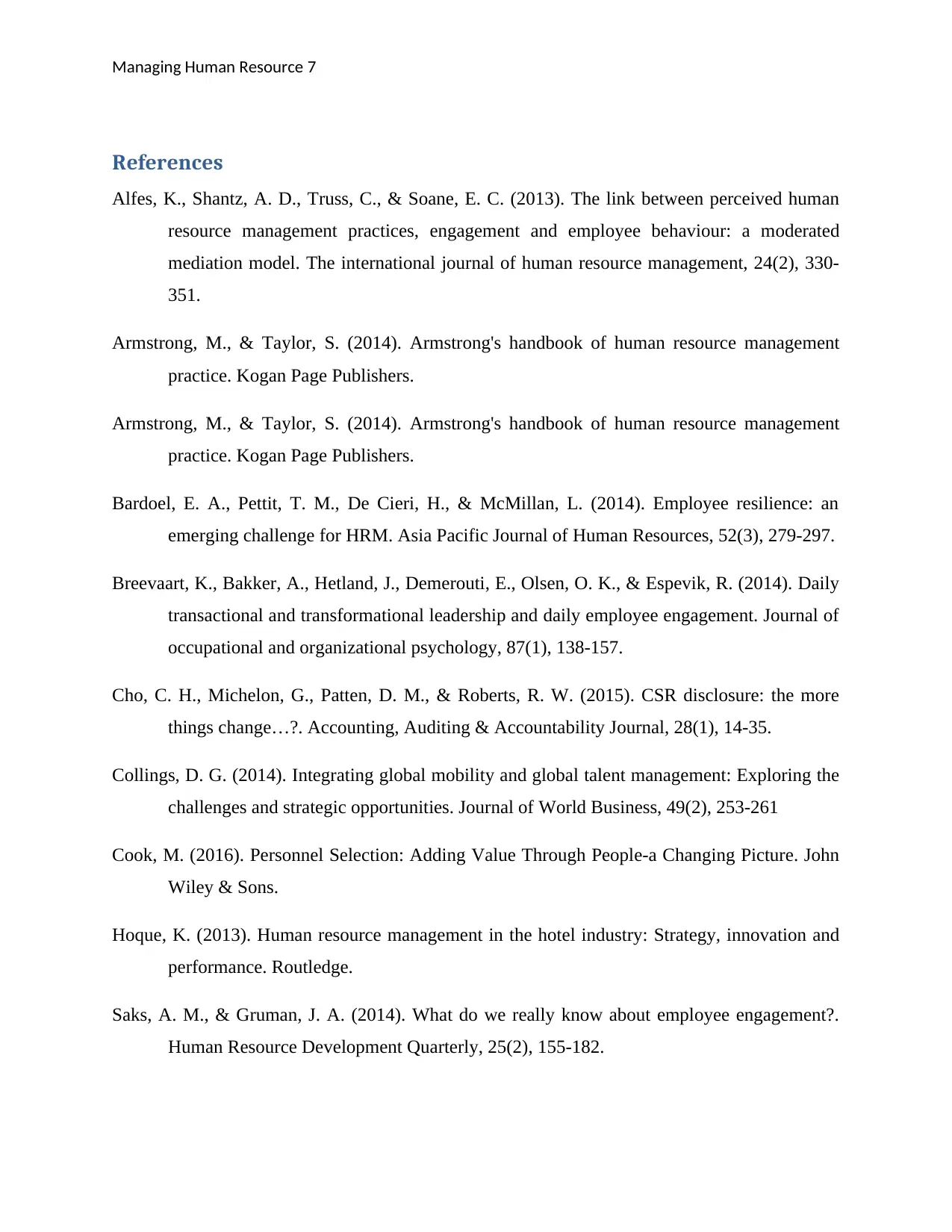
Managing Human Resource 7
References
Alfes, K., Shantz, A. D., Truss, C., & Soane, E. C. (2013). The link between perceived human
resource management practices, engagement and employee behaviour: a moderated
mediation model. The international journal of human resource management, 24(2), 330-
351.
Armstrong, M., & Taylor, S. (2014). Armstrong's handbook of human resource management
practice. Kogan Page Publishers.
Armstrong, M., & Taylor, S. (2014). Armstrong's handbook of human resource management
practice. Kogan Page Publishers.
Bardoel, E. A., Pettit, T. M., De Cieri, H., & McMillan, L. (2014). Employee resilience: an
emerging challenge for HRM. Asia Pacific Journal of Human Resources, 52(3), 279-297.
Breevaart, K., Bakker, A., Hetland, J., Demerouti, E., Olsen, O. K., & Espevik, R. (2014). Daily
transactional and transformational leadership and daily employee engagement. Journal of
occupational and organizational psychology, 87(1), 138-157.
Cho, C. H., Michelon, G., Patten, D. M., & Roberts, R. W. (2015). CSR disclosure: the more
things change…?. Accounting, Auditing & Accountability Journal, 28(1), 14-35.
Collings, D. G. (2014). Integrating global mobility and global talent management: Exploring the
challenges and strategic opportunities. Journal of World Business, 49(2), 253-261
Cook, M. (2016). Personnel Selection: Adding Value Through People-a Changing Picture. John
Wiley & Sons.
Hoque, K. (2013). Human resource management in the hotel industry: Strategy, innovation and
performance. Routledge.
Saks, A. M., & Gruman, J. A. (2014). What do we really know about employee engagement?.
Human Resource Development Quarterly, 25(2), 155-182.
References
Alfes, K., Shantz, A. D., Truss, C., & Soane, E. C. (2013). The link between perceived human
resource management practices, engagement and employee behaviour: a moderated
mediation model. The international journal of human resource management, 24(2), 330-
351.
Armstrong, M., & Taylor, S. (2014). Armstrong's handbook of human resource management
practice. Kogan Page Publishers.
Armstrong, M., & Taylor, S. (2014). Armstrong's handbook of human resource management
practice. Kogan Page Publishers.
Bardoel, E. A., Pettit, T. M., De Cieri, H., & McMillan, L. (2014). Employee resilience: an
emerging challenge for HRM. Asia Pacific Journal of Human Resources, 52(3), 279-297.
Breevaart, K., Bakker, A., Hetland, J., Demerouti, E., Olsen, O. K., & Espevik, R. (2014). Daily
transactional and transformational leadership and daily employee engagement. Journal of
occupational and organizational psychology, 87(1), 138-157.
Cho, C. H., Michelon, G., Patten, D. M., & Roberts, R. W. (2015). CSR disclosure: the more
things change…?. Accounting, Auditing & Accountability Journal, 28(1), 14-35.
Collings, D. G. (2014). Integrating global mobility and global talent management: Exploring the
challenges and strategic opportunities. Journal of World Business, 49(2), 253-261
Cook, M. (2016). Personnel Selection: Adding Value Through People-a Changing Picture. John
Wiley & Sons.
Hoque, K. (2013). Human resource management in the hotel industry: Strategy, innovation and
performance. Routledge.
Saks, A. M., & Gruman, J. A. (2014). What do we really know about employee engagement?.
Human Resource Development Quarterly, 25(2), 155-182.
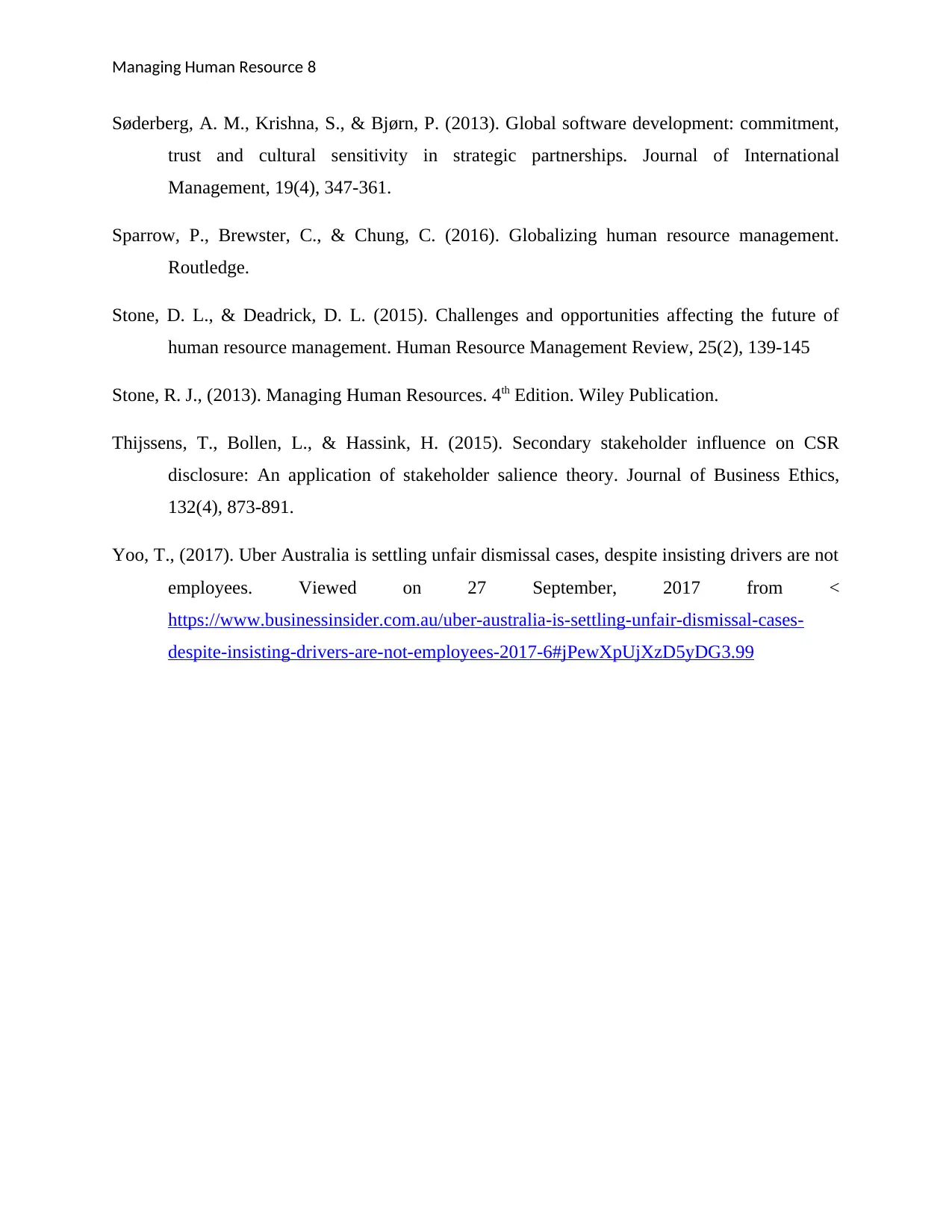
Managing Human Resource 8
Søderberg, A. M., Krishna, S., & Bjørn, P. (2013). Global software development: commitment,
trust and cultural sensitivity in strategic partnerships. Journal of International
Management, 19(4), 347-361.
Sparrow, P., Brewster, C., & Chung, C. (2016). Globalizing human resource management.
Routledge.
Stone, D. L., & Deadrick, D. L. (2015). Challenges and opportunities affecting the future of
human resource management. Human Resource Management Review, 25(2), 139-145
Stone, R. J., (2013). Managing Human Resources. 4th Edition. Wiley Publication.
Thijssens, T., Bollen, L., & Hassink, H. (2015). Secondary stakeholder influence on CSR
disclosure: An application of stakeholder salience theory. Journal of Business Ethics,
132(4), 873-891.
Yoo, T., (2017). Uber Australia is settling unfair dismissal cases, despite insisting drivers are not
employees. Viewed on 27 September, 2017 from <
https://www.businessinsider.com.au/uber-australia-is-settling-unfair-dismissal-cases-
despite-insisting-drivers-are-not-employees-2017-6#jPewXpUjXzD5yDG3.99
Søderberg, A. M., Krishna, S., & Bjørn, P. (2013). Global software development: commitment,
trust and cultural sensitivity in strategic partnerships. Journal of International
Management, 19(4), 347-361.
Sparrow, P., Brewster, C., & Chung, C. (2016). Globalizing human resource management.
Routledge.
Stone, D. L., & Deadrick, D. L. (2015). Challenges and opportunities affecting the future of
human resource management. Human Resource Management Review, 25(2), 139-145
Stone, R. J., (2013). Managing Human Resources. 4th Edition. Wiley Publication.
Thijssens, T., Bollen, L., & Hassink, H. (2015). Secondary stakeholder influence on CSR
disclosure: An application of stakeholder salience theory. Journal of Business Ethics,
132(4), 873-891.
Yoo, T., (2017). Uber Australia is settling unfair dismissal cases, despite insisting drivers are not
employees. Viewed on 27 September, 2017 from <
https://www.businessinsider.com.au/uber-australia-is-settling-unfair-dismissal-cases-
despite-insisting-drivers-are-not-employees-2017-6#jPewXpUjXzD5yDG3.99
⊘ This is a preview!⊘
Do you want full access?
Subscribe today to unlock all pages.

Trusted by 1+ million students worldwide
1 out of 9
Related Documents
Your All-in-One AI-Powered Toolkit for Academic Success.
+13062052269
info@desklib.com
Available 24*7 on WhatsApp / Email
![[object Object]](/_next/static/media/star-bottom.7253800d.svg)
Unlock your academic potential
Copyright © 2020–2025 A2Z Services. All Rights Reserved. Developed and managed by ZUCOL.





